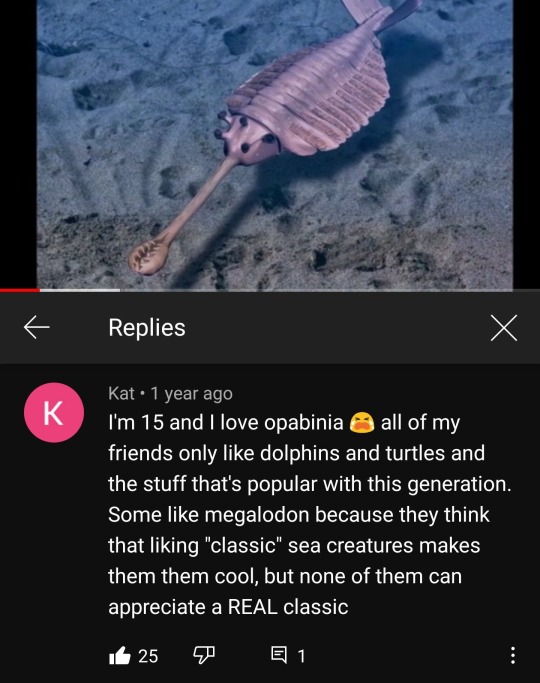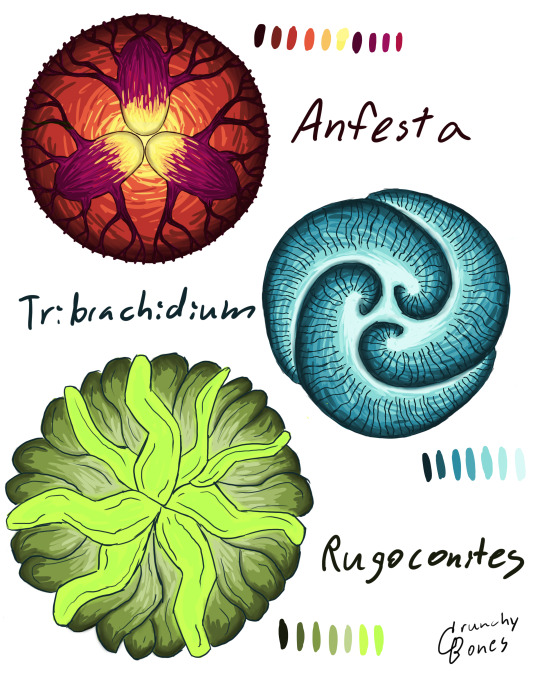#tribrachidium
Explore tagged Tumblr posts
Text

At the start of the Neoproterozoic, the first animals would emerge, and after surviving another series of ice ages, we would see the first complex life, although for now it is still very simple and seemingly alien. It is still a subject of debate how these creatures fit into the tree of life. Are they the earliest ancestors of modern life? Are they simply an entirely separate branch that died off after this period? Scientists still aren't sure. I may do a separate post about the bizarre fauna of the Ediacaran period.
At this point we're already around 4 billion years into the story of Earth, with only about 500 million years to the present. Tomorrow we will be exploring a whole new eon.
#Ediacaran#journey through time#paleoart#paleontology#evolution#Neoproterozoic#proterozoic#precambrian#charnia#dickinsonia#spriggina#kimberella#haootia#tribrachidium
13 notes
·
View notes
Text

Birthday boy at the bottom of an ancient ocean
#unlabelled drawing tag#vocaloid#kaito#yeah this is the last time i'm doing lineless art *blows up and dies*#i did my best to make these as scientifically accurate as possible. idk how well i did#i know charnia + lantianella lived before the others but i have seen reconstructions with charnia amongst the other guys#jury's still out on lantianella so i'm invoking my artistic license just this once#in terms of colours it's anywhere between ''yeah a lot of the reconstructions for this organism are a similar colour''#and ''fuck it we ball''#some of the smaller stuff is meant to be tribrachidium as well as smaller dickinsonias but they're too small to properly tell#there's also another organism behind kaito however i forgot what it was called u_u sorry#anyway. i hope i did an okay job in both that regard + this whole thing looking nice#id in alt text#ik im probably posting this too early however. i donot caare
131 notes
·
View notes
Text
Prehistoric Nature is my favorite Minecraft mod hands-down. I just made a precambrian dimension portal, emptied my inventory completely, and spent a solid 30 minutes walking through a hadean wasteland just to stare at a low-poly version of the ediacaran biota for a few seconds.
4 notes
·
View notes
Text

Trilobozoans (also known as triradialomorphs) are some of the more enigmatic members of the Ediacaran biota. In the past their unique three-way-symmetrical body plan was interpreted as linking them to groups like sponges, cnidarians, or echinoderms, but currently they're considered to be their own weird little phylum with uncertain evolutionary affinities, classified no more specifically than "probably some sort of early eumetazoan animal".
Lobodiscus tribrachialis is a newly-described member of this mysterious lineage. It lived in warm shallow marine waters covering what is now Southwestern China, and with an age of around 546 million years it's currently the youngest known trilobozoan, extending the group's time range by several million years.
About 3.7cm in diameter (~1.5"), it had the characteristic trilobozoan disc-shaped shield-like body, with a central depression surrounded by three triradially-symmetric lobes with branching ridges and grooves.
Its body would have been soft but fairly rigid, and it's not clear if it was capable of moving over the seafloor or if it had a more static lifestyle. Like its relative Tribrachidium it was probably a filter feeder, with the grooves on its surface directing water flow towards the central depression – and this surface ornamentation may also have been covered with cilia that actively caught and transported suspended food particles.
———
NixIllustration.com | Tumblr | Patreon
References:
Ivantsov, A. Yu, and M. A. Zakrevskaya. "Trilobozoa, Precambrian tri-radial organisms." Paleontological Journal 55 (2021): 727-741. https://doi.org/10.1134/S0031030121070066
Ivantsov, Andrey, Aleksey Nagovitsyn, and Maria Zakrevskaya. "Traces of locomotion of Ediacaran macroorganisms." Geosciences 9.9 (2019): 395. https://doi.org/10.3390/geosciences9090395
Hall, C. M. S., et al. "The short-lived but successful tri-radial body plan: a view from the Ediacaran of Australia." Australian Journal of Earth Sciences 67.6 (2020): 885-895. https://doi.org/10.1080/08120099.2018.1472666
Rahman, Imran A., et al. "Suspension feeding in the enigmatic Ediacaran organism Tribrachidium demonstrates complexity of Neoproterozoic ecosystems." Science Advances 1.10 (2015): e1500800. https://doi.org/10.1126/sciadv.1500800
Zhao, Mingsheng, et al. "A putative triradial macrofossil from the Ediacaran Jiangchuan Biota." Iscience 27.2 (2024). https://doi.org/10.1016/j.isci.2024.108823
Wikipedia contributors. “Lobodiscus.” Wikipedia, 29 Mar. 2024, https://en.wikipedia.org/wiki/Lobodiscus
Wikipedia contributors. “Trilobozoa.” Wikipedia, 10 Mar. 2024, https://en.wikipedia.org/wiki/Trilobozoa
#science illustration#paleontology#paleoart#palaeoblr#lobodiscus#trilobozoa#triradialomorpha#eumetazoa#animal#ediacaran#art#or maybe just precambrian disc golf
318 notes
·
View notes
Text








Ediacara! If there’s any others I’m missing let me know!
Dickinsonia - Charnia
Spriggina - Mawsonites
Aspidella - Kimberella
Parvancorina - Tribrachidium
Shop || Phone Wallpapers
49 notes
·
View notes
Text
Perspectives #4

"Silent Sea" Dickinsonia/Kimberella/Tribrachidium Ediacaran, 556 million years ago, Ediacara Hills (Australia)
The Ediacaran Biota were a motley crew of strange animals of lineages unseen anywhere else. Many of them break traditional symmetry, and most were soft-bodied. Dickinsonia, the background critter, was a proarticulate displaying glide symmetry (probably), a sort of staggered segmentation unseen in any animal today. It slowly crawled over the seabed, grazing on microbial mats. Kimberella are the slugs, probably distantly related to today's mollusks. It seems like the overall plan of "lay low, have a shell and crawl on the floor" has served them well. Tribrachidium are the spiral guys, small filter feeders that used their unique shape to funnel water into their centers. Triradial symmetry is similarly unseen in modern life.
This is part 3 of my Perspectives series! For more, check out #perspectives on my blog.
#paleoart#ediacaran#precambrian#perspectives#yee art#ocean#nature art#nature#paleoblr#palaeoblr#paleobiology#paleontology
33 notes
·
View notes
Text

A 3D model of Albumares brunsae, a Trilobozoan that hails from the Ediacaran of the White Sea, Russia.
These little things only grew up to around 1.5 - 2 cm in diameter, making them the smallest of their phylum. They are also amongst the few to have curved lobes (The other two being Lobodiscus and Tribrachidium
6 notes
·
View notes
Text




Tribrachidium of the Trilobozoa, extinct Precambrian sea floor tri-radial organisms (550 million years ago)
8 notes
·
View notes
Text

My favourite Ediacaran what-the-fuck Tribrachidium

36K notes
·
View notes
Text
Episode 1 of Aventurica Incorporated podcast - Tribrachidium - is out now

1 note
·
View note
Text
I paleontologi trovano le prime prove della selezione degli habitat nell'Ediacarano
Ecco come appariva Obamus coronatus, un minuscolo animale a corpo molle di forma toroidale del biota ediaco dell’Australia meridionale. I paleontologi hanno esaminato la distribuzione geografica di Tribrachidium, Rugoconites e Obamus, tre membri relativamente comuni del biota ediacariano (550 milioni di anni fa). “I mari dell’Ediacarano erano un luogo in gran parte estraneo rispetto agli…

View On WordPress
0 notes
Photo

Some drawings I did in photoshop of Trilobozoa because I wanna get a tattoo of them. I think it’d be neat if I got glow-in-the-dark ink for the light parts. Definitely not enough art out there of these beauties.
#trilobozoa#paleontology#precambrian#ediacaran#tribrachidium#anfesta#rugoconites#extinct species#paleoart#ocean creatures
38 notes
·
View notes
Text

For all the long eons of the Earth, the shores have remained empty. But now, something is stirring in the depths, and after each storm that rages across the seemingly barren world, strange creatures wash up on the beach. In death, they announce to the land the first animal life in the Ediacaran sea.
I've wanted to draw the strange Ediacaran life that pre-dated even the Cambrian explosion for a while now, but had been struggling to find an interesting way to depict them. With little behaviour to show, I find Ediacaran paleoart has a bit of a tendency to end up looking like a pretty aquarium with all the organisms nicely arranged together for the viewer's enjoyment. I landed on painting them washing up on the empty shore. It's also me experimenting with watercolours instead of my usual coloured pencils.
#ediacaran#paleoart#palaeoblr#paleoblr#dickinsonia#charnia#tribrachidium#spriggina#albumares#rigonia#haootia#swartpuntia#ediacaran biota#vendobiont#my art#cw: animal death#watercolour
28 notes
·
View notes
Photo

Tribrachidium in space!
Little postcard doodle.
2 notes
·
View notes
Photo

Unsolved Paleo Mysteries Month #17 -- Enigmatic Ediacarans
Although Precambrian fossils have been known since the mid-1800s, the overwhelming belief among 19th and early 20th century scientists that complex life couldn’t have originated that early meant such discoveries either weren’t taken seriously or were forcibly assigned to a Cambrian age. It wasn’t until the discovery of Charnia in the 1950s that views began to change.
(Or, rather, the second discovery of Charnia, since the schoolgirl who first found it wasn’t taken seriously either.)
Since then, a wide variety of strange soft-bodied fossils have been identified from over 30 different localities around the world, on every continent except Antarctica, dating to ages from over 600 to 542 million years ago. They’re now known as the Ediacaran biota, after the Ediacara Hills in Australia where some of the most famous examples have been found.
A few show possible similarities to known groups, but we still don’t know what sort of lifeforms most of them they actually were. Animals, fungi, algae, foraminifera, microbial colonies, or lichens have all been proposed -- but they might also belong to a completely unique kingdom or phylum, a “failed experiment” in multicellular life with no living descendants.
And they’re gradually turning out to be not nearly as “simple” as once thought, showing evidence of their own thriving ecosystems and evolutionary specializations -- which makes their sudden disappearance at the end of the Ediacaran Period all the more mysterious.
Tribrachidium has been found in Australia, Ukraine, and Russia (558-555 mya), grew up to 5cm in diameter (2″), and shows unusual tri-radial symmetry. Affinities to both cnidarians and echinoderms have been suggested, but no classification has really stuck. Recent 3D modelling and fluid dynamic studies reveal its shape was adapted to direct water currents into the nooks between its “arms”, allowing it to feed on suspended organic particles.
Yorgia is known from Australia and Russia (~555 mya), and appears to be a transitional form between two other ediacarans, Dickinsonia and Spriggina. It has what appears to be a “head” end with an asymmetrical lobe, and a segmented body in a glide reflection pattern, growing up to 25cm long (10″). Trace fossils from its feeding strategy have also been found -- chains of imprints over seafloor microbial mats, where it moved from spot to spot and “grazed” with the entire underside of its body.
Fractofusus is somewhat older (575-560 mya) and perhaps even stranger. Discovered in Canada in 1967, it was known only as “the spindle organism” for 40 years before being finally named in 2007. Its 40cm long form (16″) shows fractal self-similarity, made up of frond-like elements that branch even further again and again and again, creating a large surface area relative to its internal volume that may have been used to directly absorb nutrients from the surrounding seawater. It also seems to have been capable of reproducing in two different ways -- producing both water-borne offspring and stolon-like clones of itself.
#unsolved paleo mysteries month#science illustration#paleontology#paleoart#palaeoblr#ediacaran#tribrachidium#yorgia#fractofusus#precambrian#art#go home evolution you're drunk
196 notes
·
View notes
